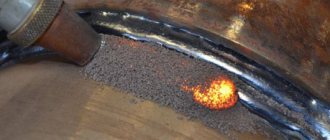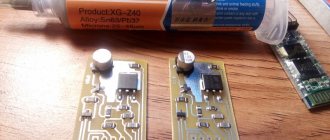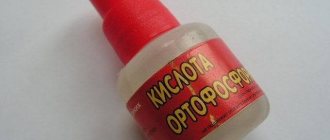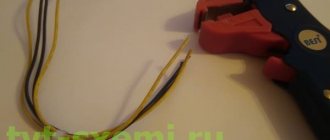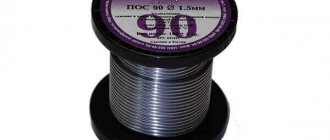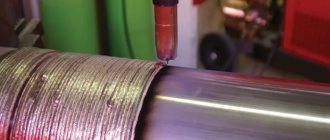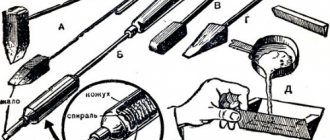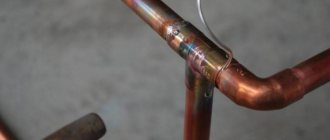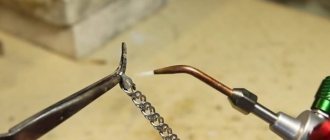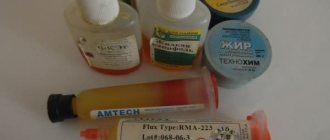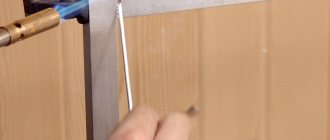What it is
Solder fat is a thick viscous paste used as a flux additive when soldering with tin-lead solders. Its main function is to remove the oxide film from the parts being soldered and prevent its reoccurrence.
The use of solder fat can significantly improve the quality of tinning and soldering, making solder joints strong and durable. Soldering fat has long earned popularity among professional solders, but only recently began to spread among home craftsmen.
Composition and properties
The chemical composition of the flux depends on its type. It may include:
for neutral fat:
- rosin;
- stearin.
for active:
- paraffin;
- technical petroleum jelly;
- water with reduced ion content;
- zinc and ammonium chlorides.
The physical and chemical properties make solder fat an excellent flux additive. Under its influence, the tin spreads over the surface of the joint, forming an extremely smooth and uniform layer. During the tinning process, a layer of tin envelops the material of the part without protrusions or depressions. Few other soldering chemistry can guarantee a similar result the first time.
Soldering with solder fat
Soldering flux is soluble in most organic solvents, such as gasoline, acetone, and white spirit. Solubility increases greatly with increasing temperature. Heated solder fat becomes more fluid and pliable, which allows it to penetrate into surface unevenness.
Homemade soldering oil
Since this material for the soldering procedure costs little, there is no point in preparing it yourself. However, there are often situations when it is urgently needed, but there is no way to purchase it, then you can make fat for soldering with your own hands.
Preparation of passive composition
The process of making passive fat is very simple. To do this, you will need the presence of a stearic substance, rosin and the following sequential steps:
- First you need to melt the rosin under high temperature, after placing it in some container;
- After this, add stearin to it and stir the mixture until smooth;
- Allow the resulting solution to cool.
Interesting to know. The solution may harden or have insufficient viscosity; in such cases, it should be heated again and more stearin should be added. This will need to be done until the consistency becomes normal for solder fat.
Stearin can be replaced with stearic acid extracted from soap, but this will complicate the process of manufacturing the desired material.
Preparation of the active composition
The process of making fat with active ingredients is a little more complicated. The percentage of substances included in its composition is as follows:
- zinc chloride salt – 10%;
- Vaseline oil – 10%;
- distilled water – 2%;
- GOI-54 paste (lubricant) – 78%.
To produce such material, you need to follow the following algorithm:
- Pour water into a porcelain mortar and add zinc chloride salt. Crush (grind) everything thoroughly;
- Add the Vaseline component to the resulting mixture and stir everything until emulsified;
- Next, you need to add GOI paste to the resulting emulsion in portions. Stir everything constantly until smooth;
- Active fat flux is ready for use.
Types of solder fat
There are two varieties on the market today:
- Neutral. A substance based on rosin and stearin. It removes oxide films and other types of contaminants well from the surface. Suitable for soldering copper parts with low-temperature solders. Universal in use, it has gained popularity both in industry and in home workshops. The thick paste allows you to very accurately measure the amount of flux required for each operation.
- Active. It has a complicated composition, to which, in addition to the stearin-paraffin base, chemically active substances are added. Ideal for soldering visibly oxidized parts made of a wide variety of metals and alloys. Not recommended for desoldering microcircuits, since active components can destroy the terminals.
Active fat flux
Active chemical components perfectly corrode and remove oxide films on parts being soldered. They also make it easier to work with materials that are difficult to solder. After finishing the work, it is necessary to remove all flux residues from the soldering zone and adjacent areas - otherwise secondary corrosion may begin, initiated by the constituent parts of the flux.
Active solder fat
Active flux is also not suitable for soldering microcircuits and other miniature parts - the leads can simply corrode. The workplace of a solder using active soldering oil must be equipped with exhaust ventilation, since chloride vapors are poisonous.
Flux can be removed either by washing with a warm soapy solution or with a specially developed Flux-Off composition.
Neutral fat flux
The combined effect of heated stearin and rosin, which are the basis of neutral solder fat, dissolves the film of oxides on the surface of the parts being processed. This guarantees convenient, high-quality and fast operation. The neutral composition increases the fluidity of the tin-lead melt, allowing it to fill the gaps and roughness of the workpieces. After sintering at high temperatures, the flux forms a coating on the surface of the material that prevents corrosion.
Neutral solder fat
Neutral solder fat is suitable for most materials except aluminum alloys. Used together with low-melting solders of the POS family. Excellent compatibility with temperature-sensitive components such as microcircuits and printed circuit boards. It is washed off with both organic solvents and warm soapy water.
What is solder fat
Don't let the word "fat" confuse anyone. Flux has nothing to do with organic matter. In fact, the pancreas is a chemical combination of various reagents. In its appearance and some properties the substance resembles lard. In practice, two types of flux are used: neutral and active flux.
Advantages
Specialists and radio amateurs choose soldering oil because of a number of its advantages:
- flux ensures uniform coverage of the soldering area with solder;
- Tinning metal surfaces helps achieve a mirror effect;
- the high viscosity of the substance allows you to maintain an accurate dosage within the intended limits;
- after soldering is completed, excess gel is easily washed off with water or a special solvent;
- market availability and low price are some of the attractive features of PG.
Flaws
- The pancreas has an unpleasant odor, which is especially active during soldering;
- Active flux is aggressive towards thin contacts of electronic parts;
- Fumes from molten flux are harmful to breathing. When working, you need to use personal protective equipment (gauze bandage, glasses).
How to use soldering oil correctly
The technological process is very similar to conventional soldering using, say, rosin.
In the same way, it is important to properly prepare the soldering area: clean and degrease.
Next, the tip should be tinned to the parts being connected. The soldering pad is covered with a thin layer of fat. The tip of the electric soldering iron is immersed in flux, after which a little solder is picked up on it. The tin melt spreads over the surface of the material in an even layer and protects it from the formation of an oxide film. After tinning, you can solder the parts together. To do this, solder is added in slightly larger portions than with tinning.
The quantity should be sufficient to fill all gaps and uneven areas.
After the soldering has cooled, excess flux is removed with gasoline, isopropyl alcohol or Flux-off washing liquid.
How to use it correctly
When treating parts and metal surfaces with fat, it is necessary to take into account its distinctive properties.
The soldering solution, presented in the form of a viscous mass, makes the soldering process soft due to its consistency, where the melting point of the soldering neutral fat is approximately equal to the melting temperature of the solder.
This increases the degree of uniform spreading of the mixture over the metal. For convenient application of fat, use matches, toothpicks, and brushes.
When working with active solder fat, the first thing to consider is the chemical fumes that are generated, which negatively affect the human respiratory organs. The connection process must be carried out under a hood or in a well-ventilated area.
Despite this, professionals consider this type of fat to be the best. The soldering solution has good fluidity, a high degree of setting, and allows for quick tinning of contacts and parts b. The mixture slowly evaporates on the soldering iron tip and leaves no residue.
The product container must be durable, airtight, and make it easy to quickly apply fat to the soldering area. The total mass of the substance should be 20 g, which is the standard weight for use.
For highly qualified specialists, soldering material is produced in volumes of up to 0.5 kg. Popular brands that are in great demand are Technocom, EM, Smoltechnokhim.”
Advantages and disadvantages
Active flux has the following advantages:
- superior in soldering quality to other fluxes;
- residues are washed off with water or solvents;
- capable of providing soldering of heavily oxidized parts and surfaces;
- affordable;
- long shelf life.
The disadvantages of active fat include harmful fumes when heated and the possibility of corrosion of the joint.
Neutral soldering flux has its advantages:
- provides a high-quality compound, second only to active fat;
- easily removable residues;
- is a dielectric;
- cheapness;
- does not contain hazardous and harmful substances;
- there is no risk of corrosion at the soldering site;
- shelf-life Unlimited.
The disadvantages of a neutral composition include:
- inapplicability to heavily oxidized surfaces;
- generation of solid waste that must be flushed away.
Despite the pronounced dielectric properties, the substance has a finite resistivity. Its remains must be removed, as they can distort the parameters of low-current electrical circuits.
Advantages and disadvantages
Both types of flux have both their advantages and disadvantages. The neutral composition has the following advantages:
Neutral fat has a number of disadvantages. These include the following properties:
- it is difficult to solder parts covered with rust;
- after soldering is completed, a solid residue remains on the surface;
- soldering with it is less comfortable than with other fluxes (flux paste, LTI-120).
The active composition also has many advantages. Its advantages:
- It is better than other fluxes for soldering the surfaces of parts made of ferrous and non-ferrous metals.
- Even highly oxidized materials can be soldered with it;
- flux residue is easily removed after soldering is completed;
- the composition has a low cost and a long shelf life.
When working with active fat, precautions must be taken. It has the following features:
- when heated with a soldering iron, the composition releases harmful substances, so the workplace must be equipped with ventilation;
- to prevent corrosion, after soldering is completed, flux residues are removed from the surface;
- The active substances in the flux can damage thin wires or electronic components, so it is not suitable for delicate soldering.
This is interesting: Semi-automatic welding - in shielding gas, in carbon dioxide
Features of choice
The choice of a specific composition is determined by the list of works, materials and sizes of parts to be soldered.
For soldering ordinary, not overly oxidized parts, you can safely choose a neutral soldering flux. It is less harmful and its residues are easier to remove. In addition, there is no risk of secondary corrosion processes caused by fat residues.
If parts and structures that are heavily corroded and contaminated are used, then active fat takes advantage.
It makes sense to evaluate the packaging of the formulations. If you do not have practical experience in using this flux, or the amount of work to be done is limited, then it is better to purchase small jars.
Soldering with neutral fat
After you are convinced of the high quality of the fat and its compliance with the intended list and scope of work, you can take large packages - per unit of weight they will cost significantly less.
Distinctive features of solder fat
Neutral flux is great for working with any type of metal. The main thing here is a well-prepared surface, since it will not be able to cope with severe rust. For difficult cases, active soldering fat is used. Thanks to its unique composition, the material copes remarkably well with its main responsibilities. It helps remove all contaminants, films and oxides, and also improves the soldering properties of base materials.
The features that neutral solder fat has include its consistency. At normal temperature, it is easy to apply to the surface of the workpiece. To do this, you will need any small hard object, and some craftsmen use ordinary matches.
Appearance of soldering fat
Upon contact with a source of high temperature, the fat begins to melt and becomes more liquid. This increases the degree of spreadability of the material, the solder is better wetted and evenly distributed. Compared to rosin, the solder layer is distributed more evenly and does not leave large marks, sharp corners or nicks. It is much easier to use solder fat, as it has very pliable properties.
